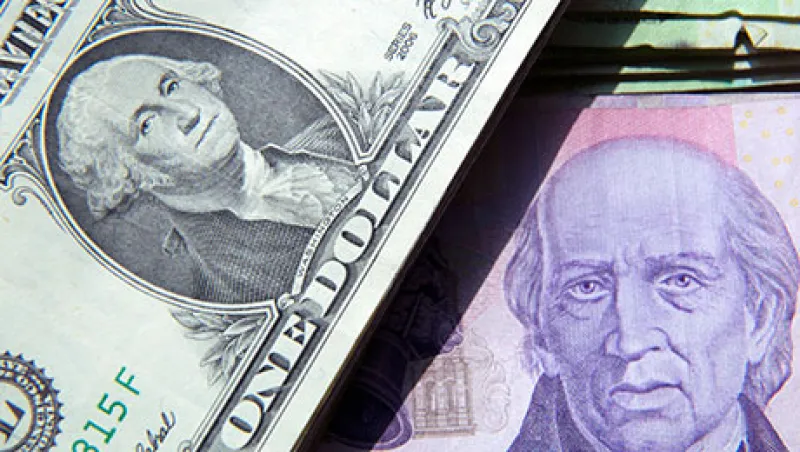When the so-called Tequila Crisis dealt Mexico the mother of all economic hangovers 20 years ago this month, the country was ill prepared for the consequences. Yet a country has rarely shaken off a financial downturn as quickly and as effectively as did Mexico. Although Mexico is now partway through a cyclical slowdown, per capita gross domestic product has nearly tripled since the trough of 1995, inflation is manageable, and the country’s ratio of debt to gross domestic product is less than 37 percent. (By comparison, Japan’s is more than 225 percent). It is remarkable what effect two decades, some painful lessons and sensible policymakers can have.
One of the biggest takeaways from the Tequila Crisis, which kicked off when the Mexican peso was suddenly devalued against the U.S. dollar, was the importance of issuing peso-denominated debt. A key cause in the crisis was the decision to issue short-term debt in dollars, which came due very quickly and cost the country dearly when the value of the peso plummeted. Mexican issues are now largely in the domestic currency, which avoids that foreign exchange risk. The terms of Mexico’s debt also tend to be much longer now, with more time for repayment.
In the early 1990s, Mexico had woefully inadequate foreign exchange reserves, which were promptly swallowed up in the peso’s tailspin. When the coffers ran dry, the U.S. was forced to step in with a bailout. Mexico has since replenished its reserve currency stockpile, growing it from a low of nearly $6 billion in 1994 to about $180 billion today. These reserves are Mexico’s way of saving for a rainy day and providing insulation for when the economy turns.
In 1991 the Bank of Mexico effectively fixed the exchange rate by allowing the peso to move within a short range against the dollar. This arrangement would be abandoned by the end of 1994 as a series of events pushed the dollar peg to the breaking point. The Federal Reserve raised rates in February of that year, and a number of subsequent domestic events caused investors to steadily lose faith in Mexico’s ability to finance its current-account deficit and triggered a full-blown rout of the peso. Mexico has maintained a floating-rate mechanism ever since, which acts as a shock absorber as confidence ebbs and flows.
Mexico’s mistakes, and the lessons it has learned, have been shared throughout the emerging-markets economies. Most fixed exchange rates have been replaced by floating systems. Local currency debt is the fastest-growing segment of the emerging-markets debt asset class. In the buildup to the Tequila Crisis, Mexico was issuing debt with a term of 28 days. Nowadays, the average duration of the local currency debt index is about seven years. In other words, issuers are trying to avoid the peril that befell Mexico.
Recent reforms under President Enrique Peña Nieto may help prevent future crises. During his first 20 months in office, Peña Nieto proposed and saw passed 11 structural reforms, including in energy, financial services and education. This zeal for economic and financial overhaul sets Mexico apart. Often, emerging markets wait until crises happen before making reforms, spooking investors and forcing policymakers into taking knee-jerk measures.
On a macro level, these changes should have a meaningful impact on consumer price inflation and make some headway toward Mexico’s ambitious 3 percent inflation target. They do not, however, hide the toxic combination of corruption and the inability of the Mexican government to enforce the rule of law. There is no better example than the abduction and execution of 43 students in September on the alleged orders of a mayor in Guerrero state. Time is not on Peña Nieto’s side to fight this particular war; however, so far his plans bode well for Mexico in the long term. His energy reforms, for example, will not be fully realized for at least a decade, long after he has left office. Breaking down Mexico’s oligopolies will actually harm the country’s stock exchange in the short term, as new competition squeezes margins. In one deal, U.S. telecom giant AT&T will acquire nearly 10 percent of Mexico’s subscribers with its $2.5 billion takeover of cell phone service provider Iusacell.
Much needs to be done to ensure that the reforms lead to the change everyone wants but that requires enlightened political leadership to attain. These reforms also show a maturity among politicians to work together, one that those north of the border would do well to emulate. Mexico’s problems are far from solved, but the outlook is good. The reforms will bear fruit. The trick is to keep away from the bottle and on the job at hand.
Edwin Gutierrez is head of emerging-markets sovereign debt at Aberdeen Asset Management in London.
Get more on emerging markets, foreign exchange and on macro .






